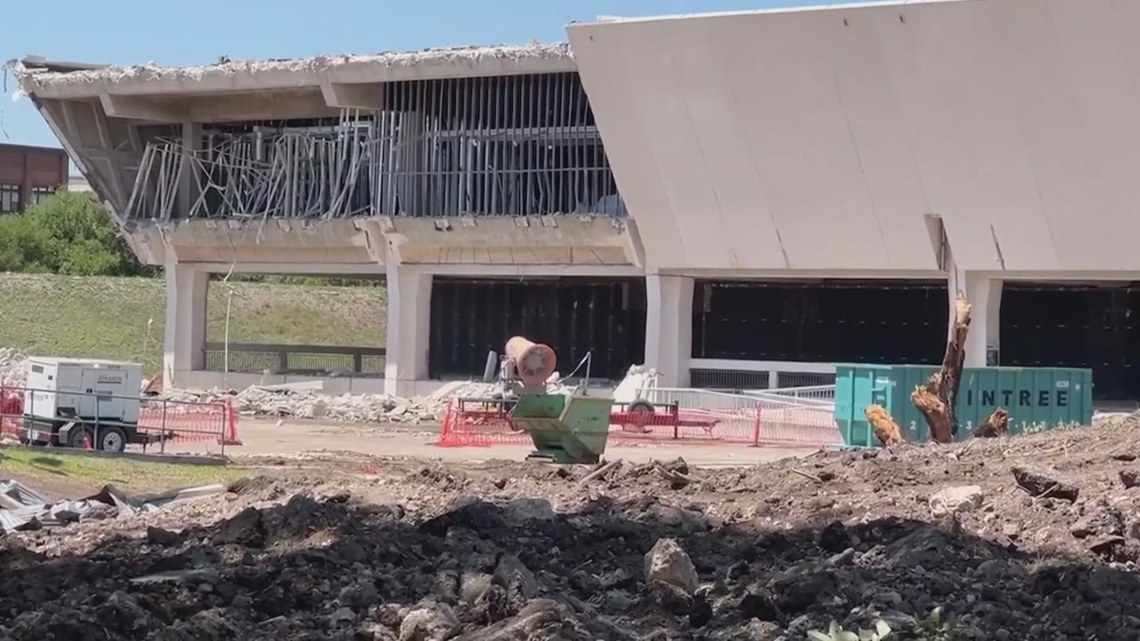The organization has argued for incorporating the current Texas Pavilion structure into Project Marvel rather than tearing it down altogether.
SAN ANTONIO — A San Antonio organization’s uphill battle to prevent the demolition of a 57-year-old downtown landmark has reached the finish line, though not its destination.
Six weeks after the Conservation Society filed a lawsuit to keep Hemisfair’s Texas Pavilion standing amid the city and Spurs’ desire to build a new arena there, the organization said its request for an emergency injunction was denied by the 15th Court of Appeals. That decision effectively snuffed the Conservation Society’s remaining legal options weeks after large portions of the Pavilion’s exterior walls were first seen torn down.
UTSA referred to that April work as “remediation” related to asbestos abatement. But officials with the Conservation Society now say “progress of demolition of the structure” since their lawsuit was first filed “has been extensive.”
“The bridge leading to the building is gone, as is the fountain that symbolized how Texans came together out of so many cultural influences,” Conservation Society President Lewis Vetter said in a statement. “Even if we were to succeed in our appeal, there is little left to save. It is already gone.”


The 13.9-acre site at 801 East Cesar E. Chavez Blvd. is managed by UTSA, but the City of San Antonio holds the right to decide in the future if it wants to sell or lease the plot of land as discussions to move the San Antonio Spurs downtown gain steam. The Pavilion until May 2024 housed the Institute of Texan Cultures, which UTSA is in the process of relocating elsewhere.
UTSA officials have not responded to KENS 5’s request for comment. It’s unknown how the end of the lawsuit affects the timeline for demolition, which the state OK’d in December.
The Conservation Society has repeatedly insisted that it isn’t against Project Marvel — the city’s grand ambitions for a downtown sports and entertainment district — but suggested that the Texas Pavilion’s “incredible” history could be retained if the building were incorporated in its current form.
The organization cited the structure’s significance due to its architect, William Peña, being a Mexican American. The Pavilion was built for the 1968 World’s Fair, after which the state “entrusted UTSA to maintain and house the state’s museum of diverse Texan cultures,” according to Preservation Texas.
“Once again,” Vetter said, “a public building is being destroyed with public dollars and no public hearing.”
A prolonged fight
The society initially filed its lawsuit to halt demolition plans on April 1, arguing it was too early to consider tearing down the structure before concrete funding frameworks for a Spurs arena are finalized.
It also claimed correct procedures weren’t followed when UTSA’s demolition was approved by the state in December. The society said a mandatory federal review didn’t happen and that requirements laid out in the Texas Antiquities Code and National Historic Preservation Act weren’t given their due diligence.
“What is the rush to tear down this building?” Vetter said in a press release issued at the time. “It has the potential for many other spectacular uses, so why tear it down when there are so many undecided issues about the proposed Spurs arena, such as public financing, the existing Spurs lease at the Frost Bank Center; tepid public support for Project Marvel; and uncertainty of state and federal transportation funds.”
The morning after the 2025 Final Four, however, some wall panels were seen being torn down at the site.
Come April 9, the society said UTSA attorneys assured them that work to remove wall panels would stop until a scheduling hearing on the pending lawsuit. Less than a week later, machinery powered up again when a Bexar County judge allowed work to continue.
According to Vetter, the judge said his court did “not have the jurisdiction to hear the lawsuit to stop the demolition.”
After that, the society filed a notice of intent to appeal. It finally reached the 15th Court of Appeals this week, where the organization was denied both an injunction and their overall effort to stop demolition.
The organization now says it will drop its suit.
“We are frustrated that the merits of our case for injunctive relief have not been herd, allowing the building to be demolished,” Vetter said. “This bodes poorly for the other historic properties owned by UTSA… if they did it once, they can do it again.”
